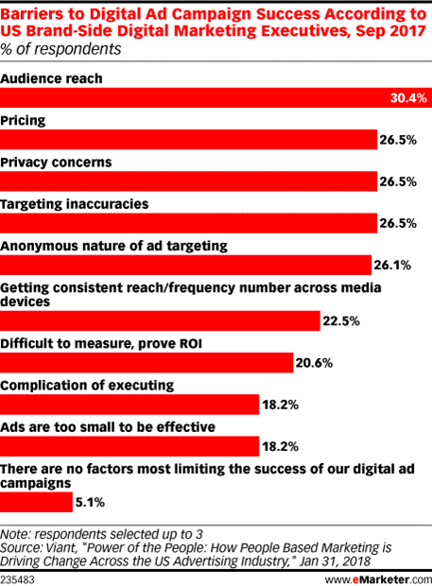The death of third-party cookies seems like the kind of thing that would break the Cookie Monster's heart. But instead, it's more a case of a marketer watching you for three weeks, distracting you with an ad, and then stealing your entire plate of custard creams.

Google's announcement that it will phase out third-party cookies on Chrome by 2022 shook stuff up. A study conducted by the company found that a world without third-party cookies would decrease average revenue for the top 500 global publishers by 52%.
Although a few browsers have gotten rid of the third-party cookie already, including Firefox and Safari, but Chrome is going to be far more significant. Google Chrome makes up 56% of the web browser market, and accounts for more than half of global web traffic.
“We became a little bit dependent on third-party cookies because it was easier, faster, and required less planning and integration [than traditional marketing],” said Matt Naeger, who heads US strategy for the performance marketing agency Merkle.
So, what now?
Cookies - who needs 'em?
Well, according to research, not many people.
In fact, 75% of mobile cookies were rejected, and 41% on desktop. Plus, even in 2018, Viant found that many marketers believed that tracking cookies would no longer be needed. Other challenges seemed more pressing, in reference to barriers to digital ad campaigns, including:
Regardless, marketers keep relying on cookies, and now must be prepared to move on.
But first up:
What's the Difference Between 1st and 3rd Party Cookies?
Well, it basically has to do with how they are created, and how they are used by the site owners.
First-party cookies are files created and stored by the domain the user is visiting. Only the site owner has access to this data. It's used to tailor browsing experiences, according to settings and preferences.
Third party cookies, on the other hand, are created by the user's browsing history, and are accessible to other platforms to leverage for their own ad targeting purposes.
So, instead of using third-party cookies, it might be time to focus on first. That's why this is the first alternative on our list:
1) Collect More First-Party Data
I mean, 88% of marketers surveyed consider beefing up their first-party data collection to be a top priority for the year.
First-party data is more accurate, and reliable, which can give you the chance to design a more targeted user experience.
So how do you collect more of it? You could try:
- Developing a solid data management strategy. CDPs, or customer data platforms, will consolidate all the information collected, allowing you to build a single coherent profile of each customer, so you can build more targeting marketing campaigns
- Leveraging all the touchpoints you have with your customers and prospects already. Think of all the data, and untapped data, you already have. This can be your social media, POS etc.
- Content creation, and other digital marketing tactics. You won't just get insights and data out of this, you'll get a stronger relationship with your customers too. And they give both willingly.
- Email marketing. 55% of marketers have reported receiving the best ROI from email campaigns. Make sure you're working with the most productive emails possible, through email hygiene, and you'll be gathering some valuable data.

2) Temporary Solutions
These temporary solutions have gradually been targeted by regulators and browsers, as they are deemed to have little respect for the privacy of users. This can include:
- Fingerprinting. Fingerprinting appears to be the most-used temporary solution
- Local storage. This can be used as a mid-term solution for clients and publishers. Local storage means storing the navigation of a given user "inside" the browser.
- Navigation data. Used to determine whether the user enters or exits a segment, navigation data storage and segment computation is performed each time a tag is fired, on each page.
3) Contextual Targeting
It may be old, but it's still relevant. Think Ian McKellen vs your old Business Studies teacher.
Contextual targeting scans site content and images in order to serve relevant ads, which means that both the ad and the site rank for similar keywords. This tactic focuses on search terms and site content, over the behavioural targeting of third-party cookies.
Basically think pizza hut advertising to people at half time during a football match i.e. buying time during tv shows with audiences similar to a brand's target demographic.
With contextual targeting, marketers can even boost brand safety. They can play a more active role in deciding where their ads will appear, and what content is safe and unsafe. But this whole thing means developing specific buyer personas, and just the right tone, in order to capitalise on contextual targeting. And you'll need first-party data.

4) New, Emerging Channels
Time for some more bullet points. Marketers might choose to consider emerging channels like:
- Advanced TV, or ATV. This includes connected TV, or CTV, and over-the-top (OTT) channels. It targets viewers through their devices using an Identifier for advertising (IFA), which is like a third-party cookie but tied to a device instead of a browser. It allows the device to collect data, but not identifiable data, which means more privacy.
- Podcast Advertising. What it says on the tin. 75% of the US population is familiar with the term 'podcasting', up from 70% in 2019. And a majority of these are in the age range of 12-34 - 48%. 35-54 makes up 40%, and 55+ being 20%.
- Walled Gardens. Google has plans to ditch third-party cookies in its Chrome web browser in favour of its own “privacy sandbox”. Jack Loughran, of the IET, reports that:
"The CMA is concerned that Google’s alternative system will create a walled garden of sorts that will “cause advertising spend to become even more concentrated on Google’s ecosystem at the expense of its competitors”.
In the walled gardens of Google, Amazon and Facebook, the customer remains logged in with these ecosystems across devices. This is why these companies have a wealth of first-party customer behavioural data at their fingertips. - Artificial Intelligence. Some software companies are creating solutions that deliver predictive data to drive marketing campaign performance. These tools can track key data points, providing insight into client engagement, helping brands optimise performance.
4) People-Based Targeting
The shift to mobile has made cross-device remarketing...difficult, since most mobile devices and apps don't accept cookies. Cookies are also device-specific, so when someone switches from mobile, to personal laptop, to work laptop, the retargeting trail goes cold. You might even end up targeting people who have converted on other devices. This is where people-based advertising comes in.
People-based advertising relies on a unique identifier that is related to the user, not the device.
"People based marketing takes a more personal approach to marketing, allowing brands to customize messaging and deliver campaigns at optimal times," says Marketing Evolution.
"People- based marketing uses customer data from both online and offline sources to create detailed, rich customer profiles. Brands use this data to determine important outcomes, like sales by each individual person over a certain period of time, patterns of media exposure, and the entire customer path-to-purchase This helps them to gain insights on what drives awareness, positive brand equity, sales, and advocacy."
People-based advertising doesn't rely on third-party cookies to track users, or gather data, and targets customers at the right time, in the right place.
According to BounceX, it all comes down to 3 key elements:
- Identification - Identify customers, and connect them to their devices.
- Data - Not just relying on historical data, brands should also refer to real-time behavioural data, and then link these points together. This gives brands a singular view of the customer.
- Automation - People based marketing automation relies on people based targeting. This means anchoring all of the data to a single source. Consequently, brands can automate an omnichannel marketing approach across all devices, under one strategy.
So, who even needs cookies?
They're so messy anyway. Leaving a bunch of crumbs behind the sofa cushions, a chocolate chip in your duvet, a couple of sultanas in the bath tub. Yes, I was eating cookies in the bath, don't judge me.

In reality. third-party cookies haven't been the most effective way of tracking customers. Even before ad blockers, consumers often cleared their cookie caches, and shared a browser with other people, leaving data noisy and incomplete.
Plus, the internet is full of bots designed to fabricate ad traffic, to generate fraudulent revenue.
"When a cookie from one site is not passed to an adtech platform, you miss a part of the puzzle and an appropriate match is not made. This happens often, and because of this, cookie match rates range from only 40 to 60 percent," says Owen Ray, of Invoca.com.
"This is why when you are searching for red Nikes on Zappos you end up getting retargeted with ads for black lingerie—which can cause other unforeseen issues for consumers at home. But, really, bad targeting from fragmented cookies is a big waste of money and annoys people with irrelevant ads."
All this means throwing a big chunk of your budget away through missed opportunities and unreached customers.

